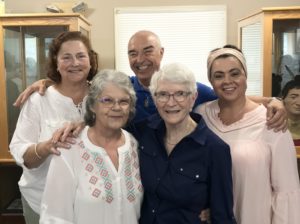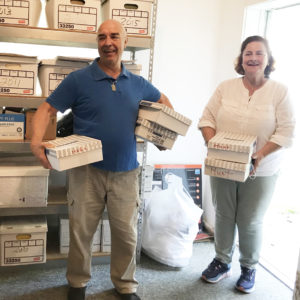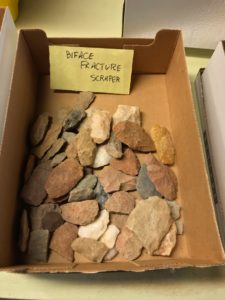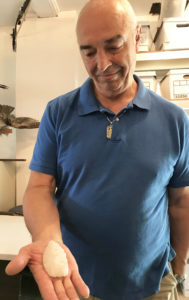Contributed by Tricia Johnson

In back row are Kathleen Kilpatrick, FHS board member; Chief Kenneth Branham and museum director Lou Branham. In front row are tribal historian Diane Shields and FHS Vice President Deborah Murdock.
The Fluvanna Historical Society traveled to the Monacan Ancestral Museum in Amherst County on Aug. 19 to deliver to the tribe a large collection of Monacan artifacts. From points to scrapers to pestles and a rare bannerstone, the collection is varied and deep. “The Fluvanna Historical Society is happy to have been careful stewards of these artifacts for some years,” said director Tricia Johnson. “We are grateful to the children of the late Ann Hunt, who amassed this collection, for placing these with us for safekeeping after her death; and we are especially grateful to the Monacan for their kindness during this repatriation process. We are also grateful to our friends at Rivanna Archaeology – Ben Ford, Nick Bon-Harper, and Susan Palazzo – who guided and advised the society through the repatriation process.”
Hunt had a fascination with Virginia Indian history and artifacts, and a keen eye for spotting them as she rode her horse on the low grounds along the James, Hardware, and Rivanna rivers in Fluvanna. The collection was donated to the society by her children after her death, and Jane Berkeley, an archaeologist who served on the historical society’s board, sorted and classified the pieces.
Now, it was time for the collection to go to Bear Mountain, where the Monacan will carefully catalog and store the artifacts; then use them to educate tribal members and visitors to the museum about the remarkable history of the Monacan in Virginia. “This museum is the heart of our community,” said Branham. “We need to know where we came from to know where we’re going. History will sometimes repeat itself some of what happened to us, we don’t want to have repeated,” he added. “We are teaching our young people and also some older people who had moved away, some of what we had to go through living here.” Branham was referring to the racism that he and his parents and grandparents experienced living in Virginia during an era when the Commonwealth was actively trying to erase their tribal identity.

Chief Kenneth Branham and FHS Board Member Kathleen Kilpatrick carry boxes of Monacan artifacts
Virginia’s “Racial Integrity Act of 1924” actually eliminated “Indian” as a racial classification in Virginia. Among the act’s strong proponents was Walter Plecker, a noted eugenicist and founder of a Richmond-based white supremacist organization; he was also the state’s first director of vital statistics. He used his position to assert his theory that all Virginia Indians had some Black ancestors, and therefore should be identified on all legal documents as “colored.” This mandate, issued by Plecker and enforced by him and his staff, essentially committed statistical genocide on the Virginia Indian tribes, many of which are only now recovering from the documentary erasure instituted by the Commonwealth. It is one of the reasons it took so long for Virginia’s Indian tribes to become federally recognized.
One Monacan midwife, Kate Johns, refused to follow the state’s requirements, and persisted in writing “Indian” on the birth certificates of Monacan babies she delivered. She was frequently chastised by the state, and even threatened with arrest. Her response, according to Chief Branham, was: “Well, if they want to arrest me, they are going to have to come up on this mountain and get me.” Years later, tribal historian Diane Shields found copies of birth certificates filled out by Johns; state employees had scratched through “Indian” on the papers and written in “colored.” Johns’ portrait has a place of honor in the Monacan museum, and her story is told as a lesson in courage and persistence.
The Monacan credit the Episcopal Mission for helping them maintain their tribal identity during those years. With a school built in 1868, and a church some years later, “(which) gave us a place to come on the weekends, be who we were and not worry about the outside world” according to Chief Branham. “The church was a major line of defense and if it wasn’t for the church we probably wouldn’t be here. A lot of people moved away because of the racism,” he added.

One box of artifacts – biface fracture scrapers – from the collection. When transported, the substantial collection filled the back of an SUV.
Today, the Monacan are working to promote their culture among tribal members; the museum exhibits contain reproductions of pottery and woven honeysuckle baskets made by the hands of modern Monacan women, who are passing the crafts down through the generations. The pots are fired at low temperatures in pits in the ground and are both beautiful and functional. “You can cook in these,” Chief Branham said, gesturing to the display of handsome pots, and added with a smile,” And I have eaten out of them!”
Conversation turned to the James River Water Authority’s plans to build a water pumping station at Rassawek in Fluvanna County, and the Monacan’s fight to preserve their ancestral capital. “My hope and dream is that we will win this battle with them, and put that property into some type of trust for preservation, so my grandchildren and great-grandchildren won’t have to fight this battle again. If we can’t save that site, there is no historic site in the state that is safe,” he warned.
Looking at a decorated and incised pottery sherd as the boxes of artifacts were unloaded and moved into the museum’s storage space, Chief Branham expressed his gratitude for the repatriation. “We definitely appreciate what you have done,” he said, “and we wish more people felt like you do about these artifacts. You are the kind of people we want to deal with, and hopefully we will have a long relationship.”

Chief Kenneth Branham holds a stemless knife made of quartz, one of the artifacts repatriated to the tribe by the Fluvanna Historical Society.
“It was a beautiful day,” said Johnson. “Taking these artifacts to the heart of the Monacan community – their museum – was a heartfelt thing, and it was the right and ethical thing to do. The society is privileged to have been able to work with the Monacan – especially Chief Branham and the tribal historians – to bring these pieces home. We hope that more institutions and repositories large and small will consider giving artifacts from their collections to the tribes where they truly belong. They aren’t ours to keep, we believe. They were simply trusted to our care for a while.”
“I’m just the most recent Monacan to hold this. Who held it 500 years ago when it was first made and used?” Chief Kenneth Branham of the Monacan cradled a beautiful, finely crafted white quartz stemless knife in both hands as he spoke, reflecting on the significance of these pieces of stone and pottery that connect the Monacan of today to their ancestors.




